- Top Trumpet Embouchure Techniques: Options for Beginners Through Professionals - October 12, 2022
- Is the Trumpet Hard to Learn? - September 30, 2022
- Best Leblanc Clarinet Models Guide: From Soprano to Contrabass - September 5, 2022
Have you ever heard a woodwind player claim their reed was why they didn’t sound good? Or are you guilty of that yourself? Then, you should read this ReedGeek review to learn if it’s the right tool for you.
Reeds can be annoying, and you may feel like you have to get a new reed all of the time. But ReedGeek solves a lot of problems by giving you control over your reeds. Consider if you should add the product to your woodwind playing toolbox.
What’s ReedGeek?
ReedGeek (sometimes misspelled as Reed Geek) is a reed adjustment tool. It helps reed players make sure their reeds will play for them easily and for longer. The company makes a few different products to help woodwind players get the best possible sound. If you’ve ever had to toss tons of reeds, ReedGeek may keep you from doing that.
You can use it to make small adjustments that could make certain reeds playable. That way, you don’t have to waste money on a box of five reeds when only one will work.
Why Use It?
ReedGeek is easy to use, so students, professionals, and everyone in between can benefit from the tool. You won’t have to buy or make new reeds as often since it can make reeds last longer.
The tool will stay sharp for years, so you don’t need to use any tools to keep it in good condition. Plus, it’s fantastic for single and double reeds, so you can use it if you only play one instrument or if you play all of the main woodwinds.
Reeds can be the bane of every woodwind player’s existence (except for flute players). Having a tool to make your reeds better is essential, and the ReedGeek rivals traditional tools, like knives.
“Universal” ReedGeek
The “Universal” ReedGeek is the main tool from this company. It’s an excellent choice for all reed players, and it comes in a few different alloys.
Classic
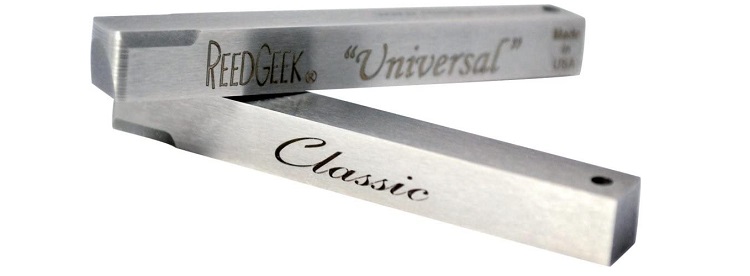
The Classic ReedGeek is the original model, and it offers plenty of features. It has four sides with crisp planing edges, so you can use it to remove cane for double and single reeds and maintain single reed flatness. This model uses chromium and has a medical-grade production process to help resist corrosion. That can also help the ReedGeek keep its shape for years.
You get a “pencil eraser” tip to help with precise adjustments, and the square back is great for profiling and scraping. It also includes two railroad adjustors, and everything comes in a self-locking neoprene bag and case for extra safety.
Pros
- Easy to use
- Versatile
- Long-lasting
Cons
- Somewhat expensive
Black Diamond “G4”

Another universal option from ReedGeek is the Black Diamond “G4” model. This tool uses an alloy that contains vanadium carbide, which protects against wear. You can use it on natural and synthetic reeds, so you don’t need a separate tool for each. The G4 tool makes it easy to get a smooth glide as you adjust your reeds.
It includes a radius tip that helps you be more precise, while the rounded back scraper helps with other adjustments. If you want something for more serious reed profiling, you can’t go wrong with the Black Diamond.
Pros
- Good for serious players
- Durable
- Fantastic features
Cons
- Pretty expensive
Special ZR

ReedGeek has also released a limited-edition Special ZR model, only available on their website. It looks similar to the other ReedGeek models, but this one has a removable stainless-steel handle. You get this tool in a neoprene bag with a microfiber cleaning cloth on the inside. That can help keep the tool looking good and working well.
It uses the most advanced alloy from ReedGeek, so you can expect this tool to last. However, that does mean it’s more expensive than the other options.
Pros
- Excellent materials
- Easy to clean
- Works well
Cons
- Limited availability
Plaque & Gauge Set
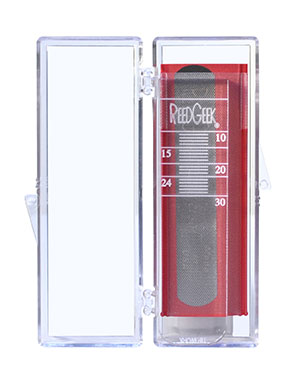
With any ReedGeek, you have the option of also getting the Plaque & Gauge Set, or you can buy it separately. The set helps you measure the mouthpiece facing length on a reed. That way, you can adjust the reed in the perfect spot to make the changes you want. Using the set will also help stabilize your reed as you work on it.
It’s an excellent tool for making more precise changes, and it’s great for players who haven’t adjusted reeds before. Plus, it’s small enough for you to keep in your case or with your other reed tools.
Pros
- Helps measure reeds
- Makes changes precise
- Available with or without the ReedGeek tool
Cons
- Not the most useful for double reeds
DoubleGeek Family
Double reed players may want to also consider the DoubleGeek Family of products. The tools are similar to the universal models, but they’re more useful for oboe and bassoon reeds.
GEN2
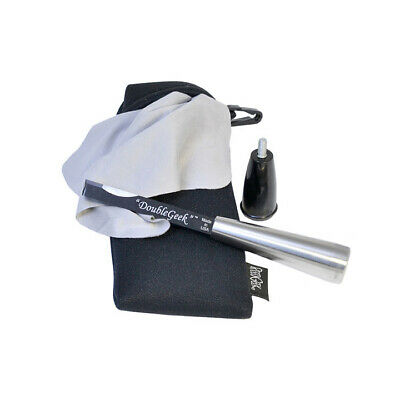
The GEN2 model features a couple of large bevels that you can use to adjust reed spines. You can get it in the Black Diamond finish, making it ideal for both natural and synthetic cane. This tool comes with 12 total cutting surfaces, so you can get the finish you want. You’ll also get a stainless steel handle and a black handle that you can swap between to make holding the DoubleGeek easier.
Everything comes in a neoprene bag with a microfiber cleaning cloth on the inside. That way, you can keep your tool clean and safe when you aren’t using it.
Pros
- Versatile
- Easy to use
- Safe
Cons
- Pretty expensive
The “Bullet”

The “Bullet” is one of the newest additions to the ReedGeek lineup. It’s perfect for adjusting and maintaining your reeds, and you can use it on oboe, bassoon, clarinet, or saxophone reeds. Like the GEN2, this one works on natural and synthetic cane. The manufacturing process gives this tool more precision than other options, so you can increase the reed’s vibrations without ruining the reed.
Each edge works well for your reeds, and the tool even features a shank file for tiny changes. It doesn’t come with a handle, but you don’t need one to use this tool.
Pros
- Easy to use
- Versatile
- Great for all reeds
Cons
- Expensive
ReedGeek Case
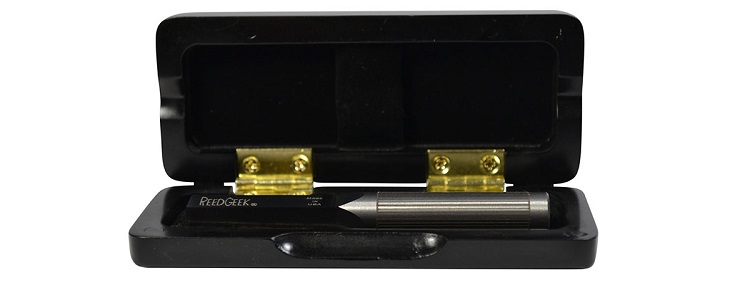
While most of the ReedGeek tools come with a neoprene bag, you may want more protection. The ReedGeek Carrying Case can keep your reed safe. The hard case can also be easier to find than the bag, so it’s great if you have a lot of accessories to carry. That way, you can find the tool when you need it.
Pros
- Good structure
- Easy to use
Cons
- Not necessary
Klangbogen Bore Stabilizer & Sound Resonator

The Klangbogen Bore Stabilizer & Sound Resonator isn’t something you can use to adjust reeds. However, it may help you get a better sound on the saxophone or clarinet. It’s a resonance bow that sits at the top of the saxophone body to help your sound shine. Meanwhile, the ClariKlang version sits just below the ligature on the mouthpiece. You can choose from multiple metal finishes:
- Heavy Silver Plate
- High Polished Brass
- High Polished 24Kt. Gold Plate
- Brushed Aerospace Matte
The models work well on clarinets and saxophones of different sizes. So if your ReedGeek tool doesn’t help you get the sound you want, the Klangbogen resonator may help.
Pros
- Easy to use
- Multiple models available
- Can improve your sound
Cons
- Not as universal as some other accessories
Ways to Use the ReedGeek Tool
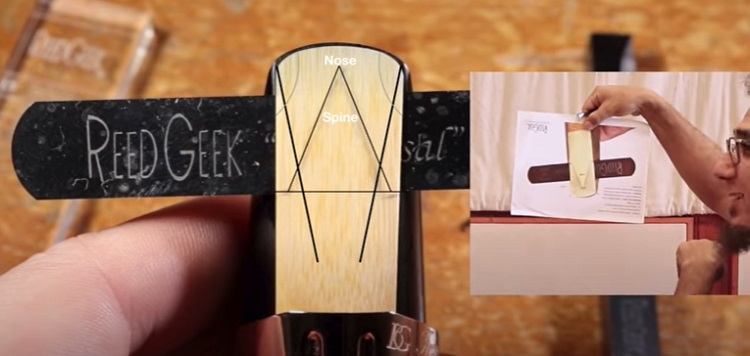
Focusing now on the reed adjustment tools from ReedGeek, you can use them in a few ways. Whether you’re a beginner reed player or a professional, maintaining your reeds is crucial.
So consider the following options to help keep your reeds in top shape so that you don’t have to replace them as often.
Flatten the Backs of Single Reeds
Having a flat reed table can help you get a clearer sound, and table warping is a common complaint from players. Flattening the backs of your saxophone or clarinet reeds is probably the best way to use the ReedGeek. Without the ReedGeek, you may need wet-dry sandpaper, glass, and flat files. However, the tool makes flattening single reeds much quicker and less messy.
You may also use a reed knife to flatten reeds, but you could accidentally remove some cane. The ReedGeek is a much better option than most alternatives.
Balance Single Reeds
You may also want to use the ReedGeek to balance the corners of the tips on your clarinet and saxophone reeds. Like flattening the backs, you can use sandpaper and glass, and that method may be more precise for some.
However, the ReedGeek is perfect for balancing your single reeds quickly. You can also do it on the go, which is nice if you have rehearsals and concerts out of the house.
It might also be an effective choice when focusing on specific spots on a reed. That way, you can get the shape and sound you want from the reed.
Scrape Bassoon Reed Channels
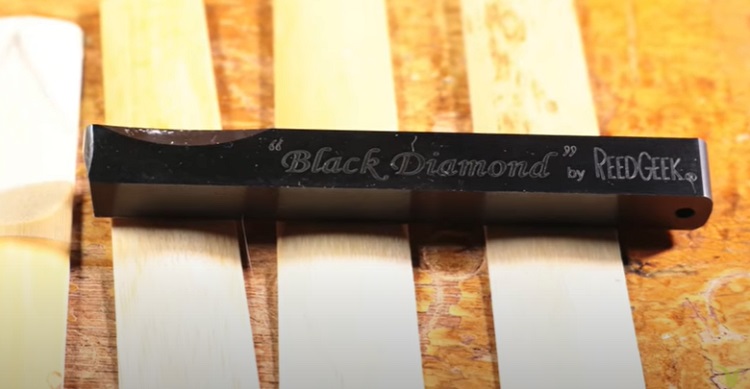
The ReedGeek features a curved edge that is perfect for scraping the channels on a bassoon reed. It makes it much easier to reach those concave spots. You can use a reed knife, but it won’t be as precise. Round files and sandpaper also work, but they can also be harder to use and get the results you desire.
ReedGeek’s founder Mauro Di Gioia explains that the tip lets you “erase” cane you don’t want. If you work on bassoon reeds often, you should consider giving the ReedGeek or DoubleGeek a try.
Smooth Oboe Reed Windows
Similar to bassoon reeds, oboe reeds require a bit of maintenance, and you need to be precise. Even if you use a reed knife to carve out windows on oboe reeds, the knife isn’t perfect.
You can use the ReedGeek to clean up your work to make sure the oboe is smooth and comfortable to play. The tool can keep you from over-gouging the reed, which is easier to do than you might think.
Who Should Use It?
The ReedGeek tool is great for a lot of people, and a good ReedGeek review should cover who it’s right for. Here are a couple of people who may benefit from using one or more ReedGeek tools.
Students
As a student, you shouldn’t have to make reeds or do a ton of adjusting. However, the ReedGeek can be a great option as you start to learn the saxophone or another reed instrument. Single reed students can use the tool to fix bad reeds, and the tool isn’t as dangerous as using a reed knife. Oboe and bassoon students can also use a ReedGeek to adjust reeds they buy from others.
Reed makers will craft reeds to their liking, but you may have different needs. So before you’re ready to learn how to make your own reeds, a tool can come in handy.
Teachers
If you want to teach a reed instrument, you’ll also benefit from the ReedGeek. Not only will you need to adjust your reeds, especially after a long week of teaching, but you might need to fix reeds for your students.
You can keep a ReedGeek in your studio for quick fixes during private lessons. If you direct a band or orchestra, you can keep the tool in your bag or on your stand to use when students have issues.
Performers
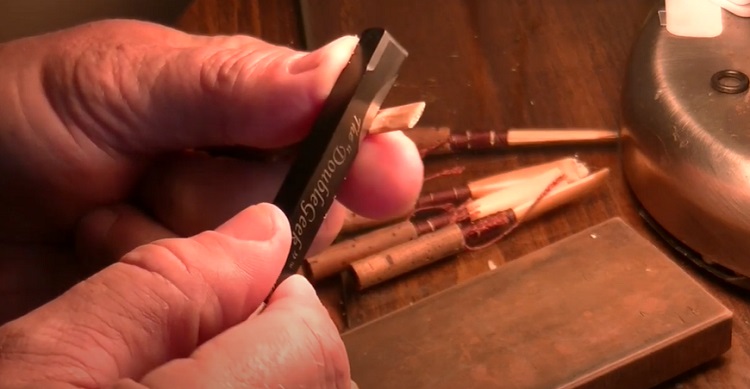
Advanced and professional performers should also consider getting a ReedGeek. You never know when your reeds may stop working, so you should be able to fix small problems yourself.
Most of the tools from ReedGeek are small enough to keep in your case. That way, you’ll have it ready to access when you need it.
Plus, you don’t need a solid workspace to use it, so it’s great to use before a rehearsal or concert. If you play multiple woodwinds, you can keep it in your music bag to make sure you have it no matter which instrument you have.
Reed Makers
If you’re a reed maker, you may not want to rely on the ReedGeek alone. However, it’s an excellent way to supplement your reed knives and other tools.
You can use the ReedGeek to finish reeds without the risk of damaging them in the process. Then, you can sell more reeds to increase your profits.
FAQs
Answer: If you’re a clarinet or saxophone player, the ReedGeek may replace other reed tools. You might not need to make adjustments with reed knives or sandpaper.
However, oboe and bassoon players will need other reed tools to make and fix their reeds. The ReedGeek is for adjustments not making reeds, so be sure to get a reed-making kit as well.
Answer: The ReedGeek is better than a reed knife because it’s not as sharp, therefore, it’s not as dangerous. ReedGeeks are also more versatile than knives because of the different edges.
It’s also relatively easy to control, so it’s great for newer reed players. You still need to be careful when using it, but it’s not as risky as using a knife or other tools.
Answer: One of the biggest concerns regarding reed knives is traveling with them on planes. Fortunately, you shouldn’t have to worry about that with the ReedGeek.
It’s not a knife, so security shouldn’t confiscate it. However, you should prepare to explain the device to the security employees. Make sure you have a copy of your receipt outlining the tool and providing proof that you own it.
Answer: The ReedGeek line of tools ranges from $60 to $130. If you’re a casual reed player, you may find the tool isn’t worth the money, but it could be worth it if you play a lot.
When you buy reeds often, you may get your money back quickly in terms of having more usable reeds. So consider how quickly you want the tool to pay for itself to decide if it’s worth the cost for you.
Answer: ReedGeek can help you increase the lifespan of individual reeds. By flattening the back of your clarinet or saxophone reeds, you may keep them from wearing out.
If you play oboe or bassoon, the tool can help you get the right finish you want. Then, you won’t have to break in a new reed as often.
Answer: Absolute beginners don’t need to use the ReedGeek. However, you may want to invest in it after you get a bit of playing experience and know you plan to continue playing.
Then, you won’t have to invest in a reed knife and other accessories. Instead, you can use the ReedGeek for most adjustments you may want to make to your reeds.
Final Note on the ReedGeek Review
When reading through a ReedGeek review, you should consider if the tool is useful for you. Fortunately, many reed players should find it helpful, even if it’s not a full substitute for other products.
If you get one, make sure you keep it safe and know where it is. Then, you’ll be able to make your reeds play better and for longer wherever you are.



